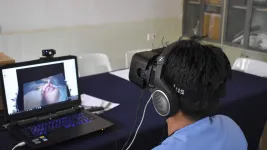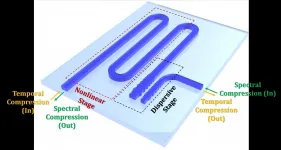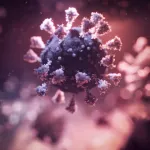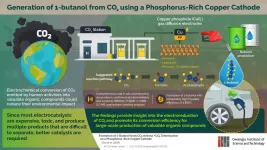New report aims to improve VR use in healthcare education
2021-07-06
(Press-News.org) A new report that could help improve how immersive technologies such as Virtual Reality (VR) and Augmented Reality (AR) are used in healthcare education and training has been published with significant input from the University of Huddersfield.
Professor David Peebles, Director of the University's Centre for Cognition and Neuroscience, and Huddersfield PhD graduate Matthew Pears contributed to the report - 'Immersive technologies in healthcare training and education: Three principles for progress' - recently published by the University of Leeds with input from range of academics, technologists and health professionals.
The principles have also been expanded upon in a letter to the prestigious journal BMJ Simulation and Technology Enhanced Learning.
The Huddersfield contribution to the report stems from research conducted over several years, which involved another former Huddersfield PhD researcher, Yeshwanth Pulijala, and Professor Eunice Ma, now with Falmouth University.
"Yeshwanth had an interest in technology and education, and in using VR for dentistry training. Matthew was looking at soft skills and situation awareness, which could be applied to investigating how dentists were able to keep a track of what was going on around them. They were similar subjects, although with different emphases, and so it seemed a natural area for collaboration."
With only a relatively small number of dental schools in the UK, the quartet visited seven dental schools in India in early 2017, with support from travel grants from Santander Bank, to test their VR-based training materials on students. The experience gained from that visit contributed to both researchers' PhDs, and ultimately led to the involvement of Professor Peebles and Matthew Pears in the new report.
The report argues for greater standardisation of how to use immersive technologies in healthcare training and education. As Professor Peebles explains, "It's about developing a set of principles and guidelines for the use of immersive technology in medical treatment. Immersive technology is becoming increasingly popular and, as the technology is advancing, it's becoming clear that there is great potential to make training more accessible and effective.
"It is important, however, that research is driven by the needs of the user and existing evidence rather than the technology. Rather than thinking 'we have a new bit of VR or AR kit, what can we do with it?', we should be looking at the problem that needs solving - what are the learning needs, so how do we use technology to solve it?
"Developing immersive training materials can be very time-consuming and difficult to evaluate properly. Getting surgeons and medical students to take time out to test your VR training is challenging. In our case we were lucky to have a surgeon, Professor Ashraf Ayoub, a Professor of Oral and Maxillofacial Surgery at the University of Glasgow, who granted us permission to film a surgical procedure that was then transformed into a 3D environment to train students about situation awareness while in the operating theatre."
Professor Peebles hopes the work so far will provide a basis for more investigations that could help get the most from the potential that VR and immersive technology have to offer.
"Conducting these kinds of studies is difficult to do well, in particular getting sufficient quantitative data that allows you to rigorously evaluate them. "As the report recommends, more collaboration is required to pool technological and intellectual resources, to try to develop a set of standards and a community that works together to boost and improve research in this area."
INFORMATION:
[Attachments] See images for this press release:

ELSE PRESS RELEASES FROM THIS DATE:
2021-07-06
A train carrying cargo has finite space. The amount of cargo that can be carried onboard is limited by the size of the cargo and the capacity of the train. Analogously, the amount of time taken up by an optical signal limits the amount of data that can be carried. Temporally shorter signals allow more data to be squeezed into a given time duration, in a method called optical time division multiplexing. Photonics researchers have recently succeeded in squeezing light in time by 11 times. The developed temporal compression system allows an equivalent increase in the number of bits transmitted by light ...
2021-07-06
A new international study has found that the key properties of the spikes of SARS-CoV-2 virus which causes COVID-19 are consistent with those of several laboratory-developed protein spikes, designed to mimic the infectious virus.
A central component in designing serological tests and vaccines to protect against COVID-19 is the manufacture of protein "spikes". These recombinant spikes closely mimic those sticking out of surface of the infectious virus and trigger the body's immune system into action.
Laboratory manufactured spikes are also used for serological testing (also referred to as antibody testing) and as research reagents. The findings show how that viral spike manufactured through different methods in laboratories across the globe ...
2021-07-06
Since July 2020, remdesivir has been conditionally approved in Europe for the treatment of coronavirus disease (COVID-19) in adults and adolescents aged 12 years and older with pneumonia who require supplemental oxygen but no invasive ventilation. In an early benefit assessment, the German Institute for Quality and Efficiency in Health Care (IQWiG) has now investigated whether the drug, which was originally developed for the treatment of Ebola virus disease, offers these patients an added benefit compared to the appropriate comparator therapy (here: therapy according to physician's choice).
This investigation yielded an indication of a considerable added benefit of remdesivir compared to the appropriate comparator therapy for adults with pneumonia ...
2021-07-06
In a study published in Physical Review Letters, academician GUO Guangcan's team from University of Science and Technology of China of the Chinese Academy of Sciences made progress in the open quantum system research. This team, collaborating with Austrian theoretical physicist Philip Taranto, demonstrated the non-Markovianity in the multi-step evolution of the open quantum system, and proved the measurement-dependent property of quantum memory effects.
In quantum information science, it is crucial to understand and control the memory effects for the development of quantum technology. For the coupling of the system and environment, the evolution of open quantum system presents the non-Markovianity, ...
2021-07-06
Faba beans have been an excellent source of food protein since pre-historic times, but about 5% of people, mostly from regions where malaria has been endemic and who carry a certain mutation, can't eat them. Now, an international team of researchers, led by the Universities of Helsinki and Copenhagen as well as Luke Natural Resources Institute Finland, has identified the gene responsible for the production of vicine and convicine, which are harmful to these people. In the work published in Nature Plants, the team reports that the VC1 gene plays a central role in the biosynthesis these compounds.
Faba beans - Pythagoras and his followers avoided them and Roman priests of Jupiter associated them with death. ...
2021-07-06
A research team led by Prof. CHEN Xianhui from University of Science and Technology of China of the Chinese Academy of Sciences (CAS) found an unusual competition between charge density wave (CDW) and superconductivity in CsV3Sb5, a layered kagome metal, which provides key experimental evidence for understanding novel CDW and superconductivity. The result was published on Nature Communications and recommended as featured article.
Traditional superconductivity and CDW are two different electronic states, which both originate from electron phonon coupling and Fermi instability. In the conventional coexistence image of CDW and superconductor, after entering the CDW state, the energy gap is opened due to the nesting of Fermi surface, resulting in the loss of density ...
2021-07-06
The stage is set for a new carbon storage economy to emerge along the Gulf Coast, according to a study led by The University of Texas at Austin, with the region offering ample opportunities to capture and store carbon, and recent state and federal incentives giving an added push to get started.
Carbon capture and storage, or CCS, is a technology that keeps CO2 out of the atmosphere by capturing emissions and storing them deep underground. It can help fight climate change by lowering industrial emissions now while renewable energy sources are being developed, said Tip Meckel, a senior research scientist at the Gulf Coast Carbon Center, a research group at the UT Bureau ...
2021-07-06
Since the discovery of the first fossil remains in the 19th century, the image of the Neanderthal has been one of a primitive hominin. People have known for a long time that Neanderthals were able to effectively fashion tools and weapons. But could they also make ornaments, jewellery or even art? A research team led by the University of Göttingen and the Lower Saxony State Office for Heritage has analysed a new find from the Unicorn Cave (Einhornhöhle) in the Harz Mountains. The researchers conclude that, in fact, Neanderthals, genetically the closest relative to modern humans, had remarkable cognitive abilities. The results of the study were published in Nature Ecology and Evolution.
Working with the Unicornu Fossile society, the scientists ...
2021-07-06
Human activities like the burning of coal and fossil fuels have caused CO2 to accumulate in the atmosphere, which has significantly affected the Earth's climate. As a result, several scientists are looking for ways to convert CO2 into other valuable organic products, such as 1-butanol, which has shown promise as an alternative fuel for vehicles. This could help reduce our dependence on fossil fuels.
One method of obtaining useful compounds is by the electrochemical reduction reaction (CO2RR). Researchers have developed metal-based catalysts that can fulfill this task. However, there is a caveat: most of these catalysts are expensive and produce a variety of products during the reaction, ...
2021-07-06
MIAMI--A new study led by scientists at the University of Miami (UM) Rosenstiel School of Marine and Atmospheric Science is the first to document what coral genes are doing in response to a disease that is rapidly killing corals throughout Florida and the Caribbean. The findings can help to better understand coral immune system as new diseases emerge as the ocean warm.
The collaborative effort between researchers at the UM Rosenstiel School, Mote Marine Laboratory and the Smithsonian Marine Station is the first to document a gene expression response of corals to stony coral tissue loss disease and that the disease causes a shared immune response in at least two coral species -- mountainous star coral (O. faveolata) and great star coral ...
LAST 30 PRESS RELEASES:
[Press-News.org] New report aims to improve VR use in healthcare education







